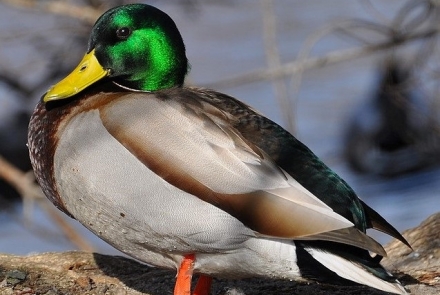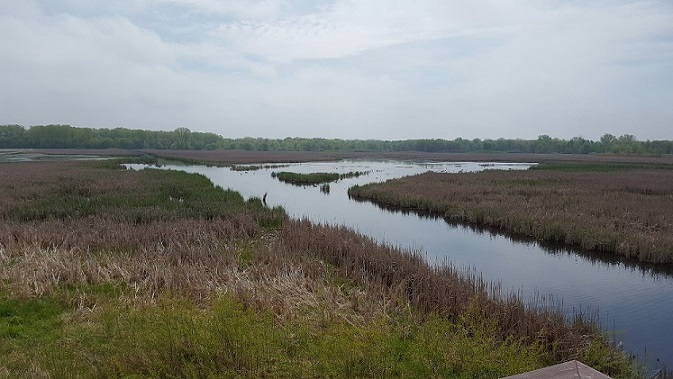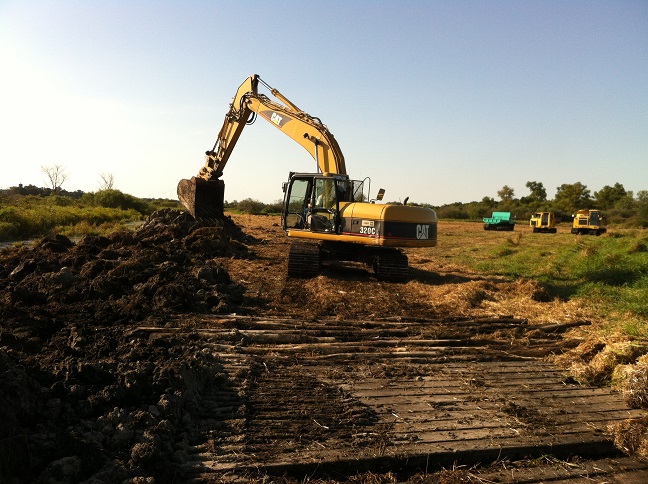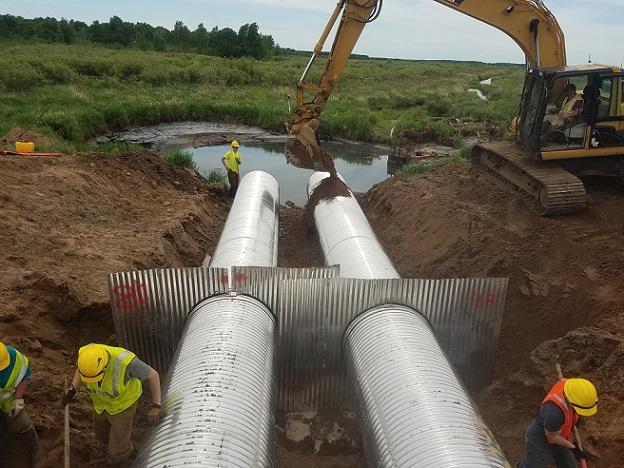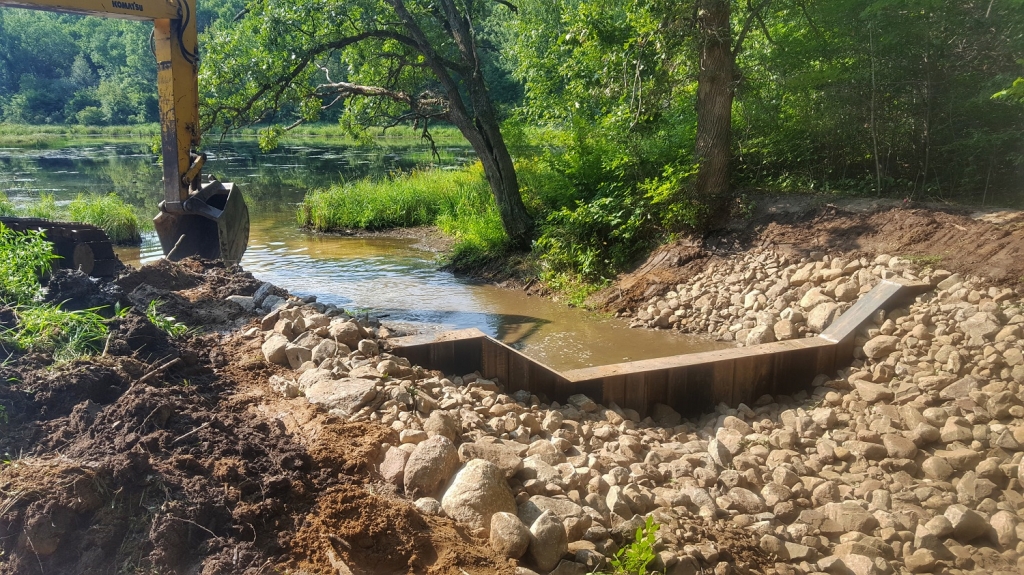Waterfowl management
Management Plan
Wisconsin Plan
Upper Mississippi River and Great Lakes Region Joint Venture
North American waterfowl management plan
WI Waterfowl Stamp
About the Wisconsin Waterfowl Stamp
Wisconsin State waterfowl (duck) stamp funds have been providing opportunities for waterfowl management and hunting in Wisconsin since 1978.
In accordance with Wisconsin Statutes s. 29.191(1)(b)1, the department shall expend 67% of the money received from fees for waterfowl hunting stamps for developing, managing, preserving, restoring and maintaining wetland habitats and for producing waterfowl and ecologically related species of wildlife. The remaining 33% is used for habitat work within Canada.
The waterfowl stamp program has generated on average over $500,000 per year during the period from 2010-2019. During that time over 160 waterfowl stamp projects have been implemented by DNR and conservation partners throughout Wisconsin. This contributes to habitat management, restoration and maintenance projects that benefit not just waterfowl, but help recharge groundwater, improve water quality, create floodwater retention, and benefit many other wildlife species as well. Yearly, waterfowl stamps contribute approximately $350,000 (67%) to wildlife projects throughout Wisconsin with much of this being used on state wildlife areas that provide wetland habitat for waterfowl in spring, summer and fall. A majority of the waterfowl stamp dollars are used as a match to receive North American Wetlands Conservation Act (NAWCA) funding, which increases conservation work across the state and brings in additional dollars to local Wisconsin economies. The following examples highlight some of the great projects that have been accomplished with the aid of the Wisconsin waterfowl stamp throughout the state.
Bergstrom Waterfowl Complex
Photo by Jason Fleener, DNR.
The State waterfowl stamp program has allocated $87,500 toward this project. The project site is located just north of the Mack State Wildlife Area in Outagamie County within the Lower Wolf River Bottomlands Natural Resource Area. The project consists of a group of four impoundments totaling 411 acres of Hemi-marsh waterfowl habitat.
Phase 1 of the project was completed on the two western impoundments, renovating dikes and replacing water control structures. Phase 2 is planned for the summer of 2019 to do the same work in the eastern cells.
Stamp funds are being leveraged with other funds and resources, including NAWCA funding, Wildlife Restoration Act (PR) funding, Ducks Unlimited, and Outagamie County to complete the project. Funding for such projects is necessary to maintain the functionality of critical infrastructure designed to provide optimal habitats for waterfowl and other birds for the enjoyment of hunters and others.
Brooklyn State Wildlife Area Wetland Restoration
Photo by Mike Foy.
At the Brooklyn Wildlife Area in Dane County, a total of $20,000 of Waterfowl Stamp funding contributed to the restoration and enhancement of 500 acres of waterfowl habitat, as well as improving the water quality of the Story Creek trout stream. Stamp funding complimented a $74,000 federal NAWCA grant to complete this project. The project, which was completed in 2015, plugged and disabled a series of historic drainage ditches and drain tiles that were no longer used for farming. Wetland restoration projects are a high priority for the Stamp program, as they bring back lost waterfowl habitats, create new opportunities for hunters and improve water quality.
Crex Meadows Wildlife Area – Refuge Pool Structure Replacement
Photo by Drew Hawley, WDNR.
In 2018, a total of $49,500 of Waterfowl Stamp funding was used to replace two outlet tubes and gates that were failing on the Refuge Extension Pool. This impacted 617 acres of impounded marsh habitat for waterfowl in Burnett County. The life expectancy of most metal water control structures on many wildlife properties is 30-50 years depending on the chemistry of the water. Routine replacement of failing structures is necessary to maintain functional wetland impoundments and prevent damages associated with dam failures. A drawdown of the impoundment is necessary to replace water control structures, which also rejuvenates marsh vegetation for waterfowl.
Mead State Wildlife Area – North Smokey Hill Flowage
Photo by Bill Hirt, WDNR.
Waterfowl Stamp funding contributed $29,200 toward the renovation of the Smokey Hill Flowage dike system, which was completed in 2018. This system contains 155 acres of emergent marsh and sedge meadow habitat important to many wildlife species. Stamp funding was used to leverage a NAWCA grant, and several local conservation organizations also contributed funding toward the project. The Mead State Wildlife Area (located in Marathon County) is one of Wisconsin’s most hunted waterfowl destinations and has heavily relied on Waterfowl Stamp funding to maintain the dozens of impounded wetland systems within it.
Private Lands – Upper Fox River Wetland Restoration
Photo by Peter Ziegler, WWA.
For the past 35 years, Wisconsin Waterfowl Association (WWA) has conducted small-scale wetland restorations throughout the state, much of which has been funded by the State Waterfowl Stamp. The 100-acre Fox River project was completed by WWA on private land northeast of Berlin in 2014. Plugging an agricultural drainage ditch and installing three water control structures restored this wetland to a natural backwater complex of the Fox River. The water control structures allow greater water management and helped re-establish wild rice on the site. Wisconsin Waterfowl Stamp funding totaling $14,000 and the associated restored acreage were then used to match a federal NAWCA grant, allowing WWA to complete other wetland restoration projects around Wisconsin.
Canadian Breeding Grounds
Wisconsin Waterfowl Stamp Funds in Canada
According to Wisconsin Statutes s. 29.191(1)(b)2, 33% of the Wisconsin State waterfowl stamp shall be used for the development of waterfowl propagation areas within Canada which will provide waterfowl for this state and the Mississippi flyway. Money for the development of waterfowl propagation areas in Canada shall be provided only to nonprofit organizations. The DNR has worked with Ducks Unlimited (DU) and Delta Waterfowl Foundation to send over $170,000 (33%) of waterfowl stamp funds to Canada each year.
These funds are spent on waterfowl production habitats where birds that migrate through Wisconsin in the fall are produced. Nearly $6 million of Wisconsin state waterfowl stamp funding has been invested in Canada (Manitoba and Saskatchewan) through the DNR’s partnerships for breeding ground habitat work since 1968. These conservation partners have received Wisconsin waterfowl stamp funds and then leveraged them more than 3-fold with sources such as North American Wetlands Conservation Act (NAWCA) funds, funds from other states and funds raised within their organizations to efficiently deliver wetland habitat work. Over 850,000 acres of habitat have been protected, restored or enhanced involving these funds.
Conservation reports
- Ducks Unlimited - FY23 Manitoba Legacy Report [PDF]
- Ducks Unlimited – FY22 Manitoba Legacy Report [PDF]
- Ducks Unlimited – FY21 Manitoba Legacy Report
- Ducks Unlimited – FY20 Manitoba Legacy Report [PDF]
- Ducks Unlimited – FY19 Manitoba Legacy Report [PDF]
- Ducks Unlimited – FY18 Manitoba Legacy Report [PDF]
- Ducks Unlimited – FY17 Manitoba Legacy Report [PDF]
- Ducks Unlimited – FY16 Manitoba Legacy Report [PDF]
- Delta Waterfowl Foundation – FY20 Manitoba Report [PDF]
- Delta Waterfowl Foundation – FY20-21 Manitoba Proposal and FY19 Report [PDF]
- Delta Waterfowl Foundation – FY18 Manitoba Report [PDF]
- Delta Waterfowl Foundation – FY18-19 Manitoba Proposal and FY16-17 Report [PDF]
Private lands
Wetlands restoration and management
- Wetlands restoration and management
- My Healthy Wetland – A Handbook for Wisconsin Wetland Owners [exit DNR]
More options
- Wildlife Management Basics [PDF]
- Restoring and Maintaining Grasslands for Wildlife [PDF]
- Restoring Shallow Wetlands for Wildlife [PDF]
- Managing Stream Corridors for Wildlife [PDF]
- Wildlife and Your Land web page
Funding sources
- Getting the Help You Need[PDF]
- Wisconsin Habitat Partnership Fund
- Voluntary Public Access and Habitat Incentive Program
Private lands contacts
The Migratory Game Bird Advisory Committee is a diverse group representing government agencies, non-governmental organizations, tribal interests and conservation groups.
Committee meeting information
This committee reviews and makes recommendations on the management of migratory game birds including ducks, geese, coots, rails, snipe, woodcock, crows and mourning doves. The committee advises the Wildlife Policy Team on a variety of topics such as hunting regulations, surveys, banding, research priorities, nuisance and health issues, seeking partnerships and designing public input opportunities.
The committee is also responsible for making recommendations on expenditures of funds available for wetland protection, restoration and management, including duck stamp revenue and North American Wetlands Conservation Act (NAWCA) grants. The committee will provide input on other wetland management and policy decisions as requested.
- November 16, 2023 meeting notes [PDF]
- March 8, 2023 meeting notes [PDF]
- Feb. 28, 2023 meeting notes [PDF]
- Nov. 28, 2022 meeting notes [PDF]
- July 7, 2022 meeting notes [PDF]
- March 2, 2022 meeting notes [PDF]
- Sept. 14, 2021 meeting notes [PDF]
- March 2, 2021 meeting notes [PDF]
- Dec. 7, 2020 meeting notes [PDF]
- Jan. 29, 2020 meeting notes [PDF]
- May 22, 2019 meeting notes [PDF]
- Dec. 17, 2018 meeting notes [PDF]
- Nov. 8, 2018 meeting notes [PDF]
- March 9, 2018 meeting notes [PDF]
- Nov. 6, 2017 meeting notes [PDF]
- May 16, 2017 meeting notes [PDF]
- Feb. 9, 2017 meeting notes [PDF]

